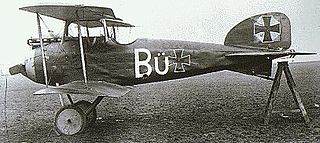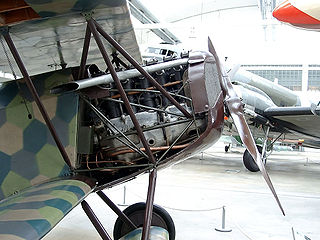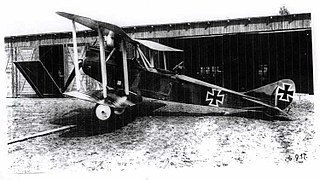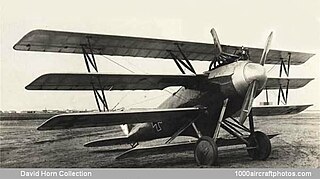
The Albatros C.III was a German two-seat general-purpose biplane of World War I, built by Albatros Flugzeugwerke. The C.III was a refined version of the successful Albatros C.I and was eventually produced in greater numbers than any other C-type Albatros.

The Albatros C.I,, was the first of the successful C-series of two-seat general-purpose biplanes built by Albatros Flugzeugwerke during World War I. Based on the unarmed Albatros B.II, the C.I reversed the pilot and observer seating so that the observer occupied the rear cockpit which was fitted with a ring-mounted 7.92 mm (0.312 in) Parabellum MG14 machine gun.

The Albatros D.I was a German fighter aircraft used during World War I. Although its operational career was short, it was the first of the Albatros D types which equipped the bulk of the German and Austrian fighter squadrons (Jagdstaffeln) for the last two years of the war.

The Fokker D.I was a development of the D.II fighter. The D.I was also flown in Austro-Hungarian service as a fighter trainer aircraft under the designation B.III. Confusing the matter further, both the D.II and D.I arrived at the Front in German service at similar times, in July–August 1916. The main designer was Martin Kreutzer.

The Mercedes D.III, or F1466 as it was known internally, was a six-cylinder SOHC valvetrain liquid-cooled inline aircraft engine built by Daimler and used on a wide variety of German aircraft during World War I. The initial versions were introduced in 1914 at 160 hp, but a series of changes improved this to 170 hp in 1917, and 180 by mid-1918. These later models were used on almost all late-war German fighters, and its only real competition, the BMW III, was available only in very limited numbers. Compared to the Allied engines it faced, the D.III was generally outdated.

The Albatros W.4 was a German floatplane derivative of the Albatros D.I fighter with new wing and tail surfaces of greater span than the D.I. One hundred eighteen examples were built between June 1916 and December 1917. The aircraft operated in the North Sea and Baltic theatres and later served as training aircraft.

The Albatros D.XII was a German single-seat fighter biplane first flown in March 1918. It was the last of the Albatros fighters completed and flown before the end of World War I and had the same slab-sided fuselage seen on the Albatros D.X.
The Friedrichshafen FF.43 was a German single-seat floatplane fighter of the 1910s produced by Flugzeugbau Friedrichshafen.

The Rumpler C.IV was a German single-engine, two-seat reconnaissance biplane. It was a development of C.III with different tail surfaces and using a Mercedes D.IVa engine in place of the C.III's Benz Bz.IV. The Rumpler 6B 2 was a single-seat floatplane fighter variant with a 120 kW (160 hp) Mercedes D.III engine built for the Kaiserliche Marine.

Entering service in 1915, the Rumpler C.I,, two-seater single-engine reconnaissance biplane, was one of the first German C-type aircraft, and also one of the longest serving in its class during World War I, being retired from the last front line units only in early 1918.

Hansa-Brandenburg W.33 was a German two-seat, single-engined low-wing monoplane floatplane, which had been developed by Hansa und Brandenburgische Flugzeugwerke during World War I as a higher powered enlargement of the similar Hansa-Brandenburg W.29 and despite the increase in size the two types are very difficult to differentiate. Although the W.33 was built in small numbers during the war many license built versions were built after World War I.

The LFG Roland D.II was a German single-seat fighter of World War I. The type was manufactured by Luftfahrzeug Gesellschaft, and also by Pfalz Flugzeugwerke under license.

The LFG Roland D.III was a fighter aircraft produced in Germany during World War I.

The Otto C.I, also known as the Otto KD.15, was a German two-seat biplane reconnaissance and bomber aircraft of the First World War designed and produced by Otto Flugmaschinenfabrik. The C.I was a rare example of an aircraft flown by the Central Powers which had a pusher configuration.

The Naglo D.II was a German single seat quadruplane fighter, flown late in World War I. It took part in one of the fighter competitions but did not reach production.

The Luft-Fahrzeug-Gesellschaft (LFG) Roland D.VII was a German single seat, single engine biplane fighter aircraft built during World War I. Problems with its underdeveloped V-8 engine prevented its production.
The Schütte-Lanz D.VII was a single engine, biplane fighter aircraft designed and built in Germany towards the end of World War I.
The Albatros C.VIII N was a German large, single engine biplane bomber, intended for night time operations, It was seriously underpowered and could only carry a small bomb load.

The Albatros C.XIV was a German two seat, single engine, biplane fighter aircraft built in 1918. Only one was constructed.

The Naglo D.I was a German single seat quadruplane fighter, flown late in World War I. It took part in one of the fighter competitions but did not reach production.
















